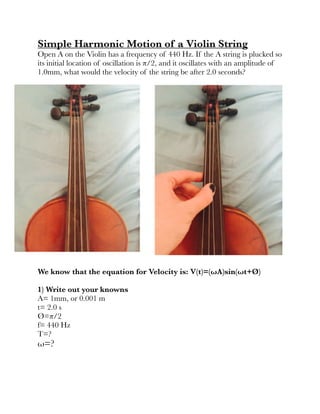Shm lo hayley sinclair
- 1. Simple Harmonic Motion of a Violin String Open A on the Violin has a frequency of 440 Hz. If the A string is plucked so its initial location of oscillation is Ï/2, and it oscillates with an amplitude of 1.0mm, what would the velocity of the string be after 2.0 seconds? ! We know that the equation for Velocity is: V(t)=(ÏA)sin(Ït+Ã) 1) Write out your knowns A= 1mm, or 0.001 m t= 2.0 s Ã=Ï/2 f= 440 Hz T=? Ï=? ! !
- 2. 2) Find your unknowns ! The period, T, can be found with the equation T=1/f, and because we know that f is 440Hz, itâs easy to solve for the period! T=1/440 ! ! Ï is equal to 2Ï/T, so just sub in our value for T. Ï= 2Ï/(1/440) ! 3) Sub into our equation for velocity ! V(t)=(ÏA)sin(Ït+Ã) V(2.0s)= [(2Ï/(1/440)rad/second)(0.001 m)] x sin[(2Ï/(1/440)rad/second)(2.0s)+(Ï/2)] ! This gives us V(2.0)=2.76460 m/s OR 2760 mm/sâĶ..Thatâs pretty fast! ! 4) Rationalize your answer Look at a simple graph of Sin, try to think of all of the variables we are using in terms of this graph. Ã describes different possible initial locations of the oscillation (in our example this is Ï/2) and A is the amplitude of the curve (1 mm). We Pulled the string 1 mm, to itâs position of Ï/2 to start the oscillation. !

![2) Find your unknowns
!
The period, T, can be found with the equation T=1/f, and because we know
that f is 440Hz, itâs easy to solve for the period!
T=1/440
!
!
Ï is equal to 2Ï/T, so just sub in our value for T.
Ï= 2Ï/(1/440)
!
3) Sub into our equation for velocity
!
V(t)=(ÏA)sin(Ït+Ã)
V(2.0s)=
[(2Ï/(1/440)rad/second)(0.001 m)] x sin[(2Ï/(1/440)rad/second)(2.0s)+(Ï/2)]
!
This gives us V(2.0)=2.76460 m/s OR 2760 mm/sâĶ..Thatâs pretty fast!
!
4) Rationalize your answer
Look at a simple graph of Sin, try to think of all of the variables we are using
in terms of this graph.
à describes different possible initial locations of the oscillation (in our
example this is Ï/2) and A is the amplitude of the curve (1 mm). We Pulled the
string 1 mm, to itâs position of Ï/2 to start the oscillation.
!](https://image.slidesharecdn.com/shmlohayleysinclair-150126014807-conversion-gate01/85/Shm-lo-hayley-sinclair-2-320.jpg)